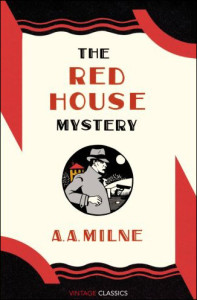 In the early years of the twentieth century, A. A. Milne was a well-known writer of plays as well as humorous essays and poems. The Red House Mystery, published shortly before he became world-famous as the creator of Christopher Robin and Winnie-the-Pooh, is his only detective novel. In his tongue-in-cheek introduction, written after the Pooh craze had struck, he explains that “it is obvious now that a new detective story, written in the face of this steady terrestial demand for children’s books, would be in the worst of taste.” For mystery enthusiasts, this is a pity — for Milne’s take on the genre was as breezily accomplished as any of his other pursuits.
In the early years of the twentieth century, A. A. Milne was a well-known writer of plays as well as humorous essays and poems. The Red House Mystery, published shortly before he became world-famous as the creator of Christopher Robin and Winnie-the-Pooh, is his only detective novel. In his tongue-in-cheek introduction, written after the Pooh craze had struck, he explains that “it is obvious now that a new detective story, written in the face of this steady terrestial demand for children’s books, would be in the worst of taste.” For mystery enthusiasts, this is a pity — for Milne’s take on the genre was as breezily accomplished as any of his other pursuits.
His accidental detective Antony Gillingham (Milne insists that the best literary detectives and villains are amateurs, whatever the case may be in real life) stumbles upon the death of a country magnate and is irresistibly drawn to try to unravel the strange circumstances surrounding it. Assisted by his faithful “Watson” (another necessity in Milne’s opinion), an old acquaintance who happens to be staying at the house, Anthony must grapple with locked doors, open windows, untrustworthy servants, unsavory relatives, and a suspicious ghost, not to mention a sinister bowling green and a croquet set that is more than it appears.
The story is not really a “whodunit” — the “who” is pretty clear from the outset — the question is “how” and, even more, “why” he did it, and Milne keeps us guessing until the end. The plausibility of the solution is not one that would hold up to heavy scrutiny, but the pleasure lies not in the verisimilitude of the puzzle but in the ingenuity of its construction and unravelling, and the witty repartee among the characters. Antony is a delightful guide throughout, treating the whole enterprise with the open-minded interest in humanity that led him to become (though possessed of a comfortable income) a valet, a newspaper-reporter, a shop-assistant. One can imagine him continuing on through a peripatetic series of adventures, ranging far and wide through society. But as it turned out, The Red House Mystery was his only chance to shine.
This Vintage Classics edition, available only in the UK, is an unusually attractive small hardcover (sans dust jacket). The cover offers an appropriately retro design in black, red, and cream on matte paper, with dramatic red-and-black endpapers (featuring a croquet motif) and an “Ex Libris” panel on the first page. The interior text appears to be a facsimile of an earlier edition, but is clean and clear to read, and includes the 1926 introduction by A. A. Milne. If you can get your hands on a copy, it would make a great gift for a lover of vintage mysteries.
(Vintage Classics, 2008; originally published 1922)
